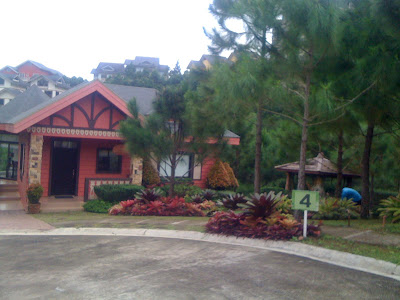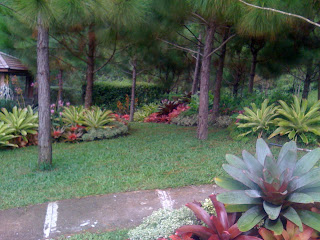Sometime early June, long-time friend CV Lazaro of Los Banos called up to ask whether I would like to exhibit in a garden show he is helping to organize. Though I have not done an exhibit in a competitive environment for a number of years and was not that hot on doing one at that time, I told CV that I was listening. It turned out it was not the typical garden show competition staged by the numerous Manila-based garden clubs. It was being organized for an exclusive subdivision development company where a select group of award winning landscape/garden designers will be commissioned to do installations in a number of key areas in the sponsoring subdivision. As CV was explaining the details, the more I became interested. The clincher of course was that the subdivision is located in windy Tagaytay City, only 10 kilometers from my farm! And so I said yes, I will participate.
On July 30, the competition was eventually launched at Crosswinds, Tagaytay City after which a meeting was held for the five competitors to draw which pre-selected area each will be working on.
Spread throughout most of the developed areas of Crosswinds, the sites included the Christmas Store, The Sales Office, Delemont 165 Model Unit, The Christmas Village, and the Montreux Gardens View Deck. In addition to myself, the participants were Rolita Spowart of VS Orchids, Rex Puentespina of Malagos Gardens in Davao and Waling Waling Flowers, Myna Frago of Forest Woods Garden and Vicente Ma. Jose Ferrer of My Mother's Garden.
I was assigned the Delemont 165 Model Unit, a well maintained area as it serves as the showcase of the company for its prospective clients/home owners.
This beautifully constructed Swiss chalet-inspired house faces a wide lawn surrounded by tall shrubs, with medium sized pine trees giving the area a distinctly alpine flavor.
On the far left side of the lawn is a beautifully constructed wooden swing, while planted in the middle is a trimmed 3-ft tall juniper hedge.
My first visit to the site was not very encouraging. The garden is already mature and beautiful in its own quiet way. It has beautiful trees and the gazebo/swing is the real focal point in the space.
The challenge is to beautify the garden without greatly damaging the existing plantings as the exhibit will last only for a few weeks and need to be removed afterwards.
Bringing in annuals in bloom would be the most obvious solution to creating excitement and adding color to the space. However, the exhibit will last for several weeks deep in the middle of the rainy season. The flowers will wilt in a matter of days, so the decision was to use colorful bromeliads instead.
We brought in alcantarea imperialis rubra to give the space a common backbone while at the same time adding subdued color and the unifying star-like shape that will be the signature of the exhibit. The biggest bromeliads were planted first. We also brought several large agave geminiflora (the spiky green plants in front of the gazebo) to give extra texture and break the possible monotony of the star-like shape. It also did not hurt that the agave's outline echoed that of the pine needles.
Layers of plants were installed to create the necessary masses, taking into consideration the color combination and the need for contrast and texture.
The view (left picture) of the house showing the plant groupings from the street approach as we are about to finish with the installation shows the color of the bromeliads echoing the color of the cottage.
Much care was taken so as not to damage the lawn as judging was to happen a day after the completion of the garden.
An arrangement of three bromeliads was placed at the left side of the gazebo while three blooming tillandsia xerograhica was tied to its right front post. This minimal planting was intentional so as to downplay the gazebo to a minor focal point and the plant composition in the middle of the lawn to being the major focal point.

The major focal point of the garden is an arrangement that combines several planting materials: the juniper hedge acting as a background, the bromeliads adding form and color, the agave geminiflora bring in texture and added interest and some flowering native orchids, vandopsis lissochiloides, adding height and botanical variety to the composition.
As bromeliads as best viewed mostly from above, the picture below shows the major focal point from another angle.
It was a great experience doing this installation. I thought that I was already over with doing these exhibits but creating under time pressure against a criteria where one will be given feedback has its own rewards.
It also did not hurt when one's creation, against a group of equally beautiful creations executed by very capable competitors ran away with the top prize!


















